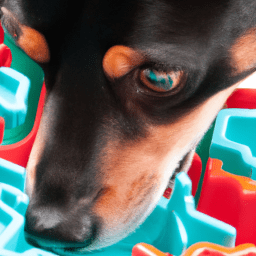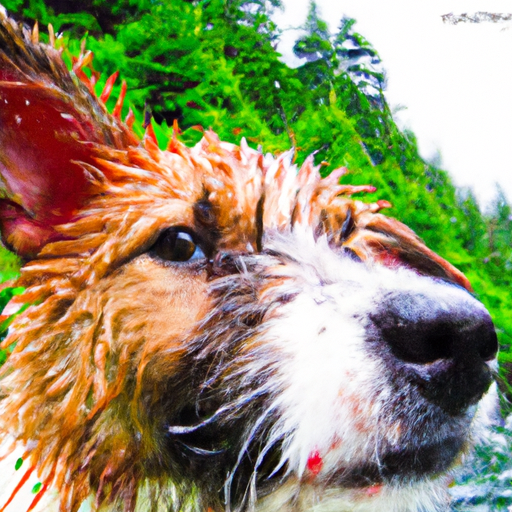In this comprehensive guide, you will discover everything you need to know about engaging your four-legged friend in the world of canine puzzle games. From the benefits these games provide to your dog's mental and physical well-being to the different types of puzzles available for dogs of all ages and abilities, this guide has got you covered. Delve into the fascinating world of canine puzzle games and unleash the hidden genius in your furry companion. Get ready for some tail-wagging fun!
Understanding Canine Puzzle Games
Canine puzzle games are interactive toys that are designed to mentally stimulate dogs and engage their problem-solving skills. These games typically involve hiding treats or toys within the puzzle, requiring the dog to figure out how to access the rewards. By providing mental enrichment and entertainment, puzzle games help keep dogs engaged and prevent boredom.
Why are puzzle games important for dogs?
Puzzle games are important for dogs because they promote mental stimulation, which is essential for their overall well-being. Dogs are intelligent creatures that thrive on mental challenges, and puzzle games provide an outlet for them to exercise their problem-solving abilities. Engaging in puzzle games can also help alleviate boredom and prevent destructive behaviors that can result from a lack of mental stimulation.
Benefits of puzzle games for dogs
There are numerous benefits to incorporating puzzle games into a dog's routine. These include:
-
Mental Stimulation: Puzzle games engage a dog's brain, keeping them mentally sharp and preventing cognitive decline.
-
Stress Relief: Solving puzzles can help dogs relax and reduce their stress levels, providing a healthy outlet for their mental energy.
-
Slow Feeding: For dogs that tend to gobble their food too quickly, puzzle games can slow down their eating and promote healthier digestion.
-
Bonding Opportunity: Playing puzzle games together can strengthen the bond between you and your dog as you work together to solve the puzzles.
-
Physical Exercise: Many puzzle games require dogs to use their paws or nose to manipulate the puzzles, providing some physical activity in addition to mental stimulation.
Choosing the Right Puzzle Game for Your Dog
When selecting a puzzle game for your dog, it's essential to consider their size, breed, skill level, and preferences. Here are some factors to keep in mind:
Consider your dog's size and breed
Different puzzle games are designed with specific sizes and breeds in mind. For example, small breed dogs may need puzzle games with smaller compartments or pieces. On the other hand, larger dogs may require more durable toys that can withstand their strength and play style.
Assess your dog's skill level
Just like humans, dogs have different levels of problem-solving skills. Some may be beginners and require simpler puzzles, while others may be more advanced and need more complex challenges. It's important to choose a puzzle game that matches your dog's skill level to keep them engaged without overwhelming them.
Determine the right type of puzzle game
There are various types of puzzle games available, each offering different challenges and rewards. Consider your dog's preferences and abilities when choosing the type of puzzle game. For example, food-dispensing puzzle toys are excellent for dogs that are food-motivated, while problem-solving puzzle toys are more suitable for dogs that enjoy mental challenges.
Safety considerations when choosing a puzzle game
Ensure that the puzzle game you choose is made from non-toxic materials and does not have any small or sharp parts that could be a choking hazard. Additionally, keep an eye out for puzzle games with a strong construction that can withstand your dog's play style and chewing habits.
Types of Canine Puzzle Games
There is a wide range of puzzle games available for dogs, each with its unique features and benefits. Here are some popular types of canine puzzle games:
Food-dispensing puzzle toys
These puzzle toys hide treats inside compartments or require dogs to manipulate the toy to access the hidden food. They provide mental stimulation and slow down fast eaters while rewarding them with tasty treats.
Problem-solving puzzle toys
Problem-solving puzzle toys require dogs to solve puzzles or complete tasks to access rewards. These toys typically involve different levels of difficulty, allowing dogs to gradually progress as they become more skilled.
Interactive puzzle toys
Interactive puzzle toys engage dogs in a more interactive manner, requiring them to push buttons, slide levers, or perform other actions to solve the puzzle. These toys provide mental stimulation while encouraging physical interaction.
Escape room puzzle toys
Escape room puzzle toys challenge dogs to figure out how to open compartments or unlock hidden areas to reveal treats or toys. These toys simulate the fun and excitement of an escape room experience for dogs.
Scent-based puzzle toys
Scent-based puzzle toys tap into a dog's exceptional sense of smell. These toys require dogs to use their noses to track down hidden treats or toys, providing an excellent mental workout.
Common Features of Canine Puzzle Games
While canine puzzle games come in various shapes and sizes, they often share common features that enhance the overall puzzle-solving experience for dogs. Some of these features include:
Various levels of difficulty
Puzzle games that offer multiple difficulty levels allow dogs to progress as they become more skilled. This ensures that the puzzles remain engaging and challenging for your dog, preventing boredom.
Adjustable challenge options
Some puzzle games come with adjustable settings that allow you to modify the difficulty level based on your dog's skill and experience. This versatility ensures that the puzzle game can adapt to your dog's abilities.
Durable and chew-resistant materials
To withstand a dog's play and chewing habits, puzzle games should be made from durable and chew-resistant materials. This ensures that the puzzles can endure rough handling without falling apart or becoming a safety hazard.
Easy to clean
Puzzle games should be easy to clean to maintain hygiene and prevent the buildup of dirt and bacteria. Look for puzzles that can be easily disassembled or have removable parts for effortless cleaning.
Engaging and interactive design
The design of puzzle games should be interactive and engaging for dogs. Bright colors, interesting textures, and enticing features can capture a dog's attention and stimulate their curiosity, making the puzzles more enticing to solve.
Training Your Dog to Use Puzzle Games
Introducing your dog to puzzle games requires some training and patience. Here are some steps to help you train your dog to use puzzle games effectively:
Introducing the puzzle game
Start by introducing the puzzle game to your dog in a calm and controlled environment. Allow them to inspect the puzzle and get comfortable with its presence. Offer rewards and praise to create a positive association with the puzzle game.
Using treats to encourage exploration
Place some treats or kibble in the puzzle game to encourage your dog to explore. Show them how they can interact with the puzzle to access the rewards. Start with simple puzzles and gradually increase the complexity as your dog becomes more familiar with the concept.
Progressive training for more complex puzzles
As your dog becomes more proficient at solving puzzles, gradually introduce more complex puzzles with different challenges. This progressive training helps keep your dog's interest and ensures they continue to be mentally stimulated.
Integrating puzzle games into daily routines
To make puzzle games a part of your dog's routine, incorporate them into their daily activities. Instead of feeding meals in a bowl, use food-dispensing puzzle toys to provide mental stimulation and slow down their eating. This creates a positive association with puzzle games and makes them an enjoyable part of your dog's day.
Creating Homemade Puzzle Games
If you're feeling creative, you can create homemade puzzle games for your dog using household items. Here are a few ideas to get you started:
DIY puzzle games using household items
Repurpose empty plastic bottles by cutting holes in them and filling them with treats. Your dog will have to figure out how to manipulate the bottle to retrieve the treats. You can also use muffin tins and tennis balls to create a homemade version of a food-dispensing puzzle toy.
Tips for ensuring safety in DIY puzzles
When creating DIY puzzles, ensure that the materials you use are safe for your dog to interact with. Avoid using items with sharp edges or small parts that could be a choking hazard. Supervise your dog closely during playtime to prevent any accidents or ingestion of non-edible materials.
Engaging your dog's senses in homemade puzzles
Consider incorporating different sensory elements into your homemade puzzles. You can add scents, textures, or sounds to make the puzzles more engaging. For example, soak a cloth in chicken broth and freeze it to create a scented ice puzzle for your dog to lick and enjoy.
Preparing Your Dog for Puzzle Game Success
To set your dog up for success in puzzle games, it's important to meet their physical and mental needs, establish a positive association with the games, and create a dedicated puzzle game area.
Meeting your dog's physical and mental needs
Before engaging in puzzle games, make sure your dog has had an opportunity to exercise and release any excess energy. A tired dog will be more focused and receptive to the mental challenges presented by the puzzle games.
Establishing a positive association with puzzle games
Make the puzzle games a rewarding and positive experience for your dog. Use treats and praise to reward them for their efforts and encourage them to engage with the puzzles. Avoid becoming frustrated or impatient if your dog doesn't immediately understand the puzzles. Patience and encouragement are key to building a positive association.
Creating a dedicated puzzle game area
Designate a specific area in your home where you and your dog can engage in puzzle games. This can be a quiet corner or a specific room where you can set up the puzzle games and create a focused and peaceful environment for play. Having a dedicated puzzle game area helps signal to your dog that it's time for mental stimulation and fun.
Troubleshooting Common Challenges
While puzzle games can be highly beneficial for dogs, they may encounter certain challenges during the process. Here are some common challenges and how to address them:
Lack of interest in puzzle games
If your dog shows a lack of interest in puzzle games, try using high-value treats or toys to make the puzzles more enticing. You can also start with simpler puzzles and gradually increase the difficulty as your dog becomes more engaged.
Overcoming frustration
If your dog becomes frustrated when solving the puzzles, take a step back and simplify the challenge. Break the puzzle into smaller steps and reward your dog for each successful completion. Gradually increase the difficulty once your dog gains confidence.
Preventing destructive behavior
In some cases, puzzle games may not be sufficient to curb destructive behavior if your dog has excessive energy or anxiety. Ensure that your dog is receiving enough physical exercise and mental stimulation through other means, such as walks, playtime, and training sessions.
Addressing difficulty levels
If your dog is consistently finding the puzzles too easy or too difficult, consider adjusting the difficulty level to keep them engaged. Look for puzzle games that offer adjustable challenge options or consult with a professional trainer for guidance.
Safety Considerations for Canine Puzzle Games
Ensuring the safety of your dog is paramount when it comes to puzzle games. Here are some safety considerations to keep in mind:
Supervision and monitoring
Always supervise your dog while they are playing with puzzle games. This allows you to intervene if they become frustrated, exhibit unsafe behavior, or if any parts of the puzzle game pose a potential choking hazard.
Choosing appropriate puzzle game sizes
Select puzzle games that are appropriate for your dog's size and breed. Avoid puzzle games with small parts that could be swallowed or lodged in the dog's throat. If in doubt, consult the manufacturer or a professional trainer for recommendations.
Avoiding small or sharp parts
Inspect the puzzle game thoroughly before giving it to your dog. Ensure that there are no small or sharp parts that could be hazardous. If the puzzle game shows signs of wear and tear, discard it and replace it with a new one to prevent any safety risks.
Regularly inspecting for wear and tear
Regularly inspect your dog's puzzle games for any wear and tear. Frayed edges, loose parts, or broken components can pose hazards to your dog. If you notice any damage, replace the puzzle game immediately to ensure your dog's safety.
Expanding Your Canine Puzzle Game Collection
Once you and your dog have mastered a few puzzle games, it can be fun to expand your collection and introduce new challenges. Here are some tips for expanding your canine puzzle game collection:
Exploring new puzzle game options
Research different puzzle games and explore new options that offer unique challenges and rewards. Look for puzzle games that target specific skills or tap into different senses to provide a varied and engaging experience for your dog.
Rotating puzzle games for variety
To keep your dog's interest intact, consider rotating the puzzle games in your collection. This prevents boredom and ensures that your dog always has something new and exciting to explore.
Seeking recommendations from other dog owners
Reach out to fellow dog owners or online communities for puzzle game recommendations. Honest reviews and personal experiences can help you discover hidden gems and find puzzle games that are well-suited for your dog's specific preferences and abilities.
In conclusion, canine puzzle games provide a fun and engaging way to stimulate your dog's mind, alleviate boredom, and promote overall well-being. By understanding your dog's unique needs and preferences, choosing the right puzzle games, and providing appropriate training and supervision, you can create a positive and enriching puzzle game experience for your furry friend. So, get ready to embark on a puzzle-solving adventure with your canine companion and watch as their intelligence and problem-solving skills shine!






